Practical Application of AASB Standards in Financial Reporting
VerifiedAdded on 2023/06/14
|8
|1968
|479
Practical Assignment
AI Summary
This assignment provides detailed solutions related to the application of Australian Accounting Standards Board (AASB) standards in various financial reporting scenarios. It covers topics such as asset recognition, including the criteria for recognizing assets like franchise agreements, employees, restaurant premises, equipment, and advertising costs, according to the AASB's Framework for the Preparation and Presentation of Financial Statements. Furthermore, it includes the preparation of a Statement of Profit & Loss and Other Comprehensive Income for Scorpio Ltd, addressing adjustments required for gains on the sale of financial assets. Finally, it discusses the treatment of changes in the useful life and residual value of equipment, providing calculations for depreciation expenses and appropriate note disclosures for financial statements. The assignment uses references to specific AASB standards to support its analysis and conclusions.
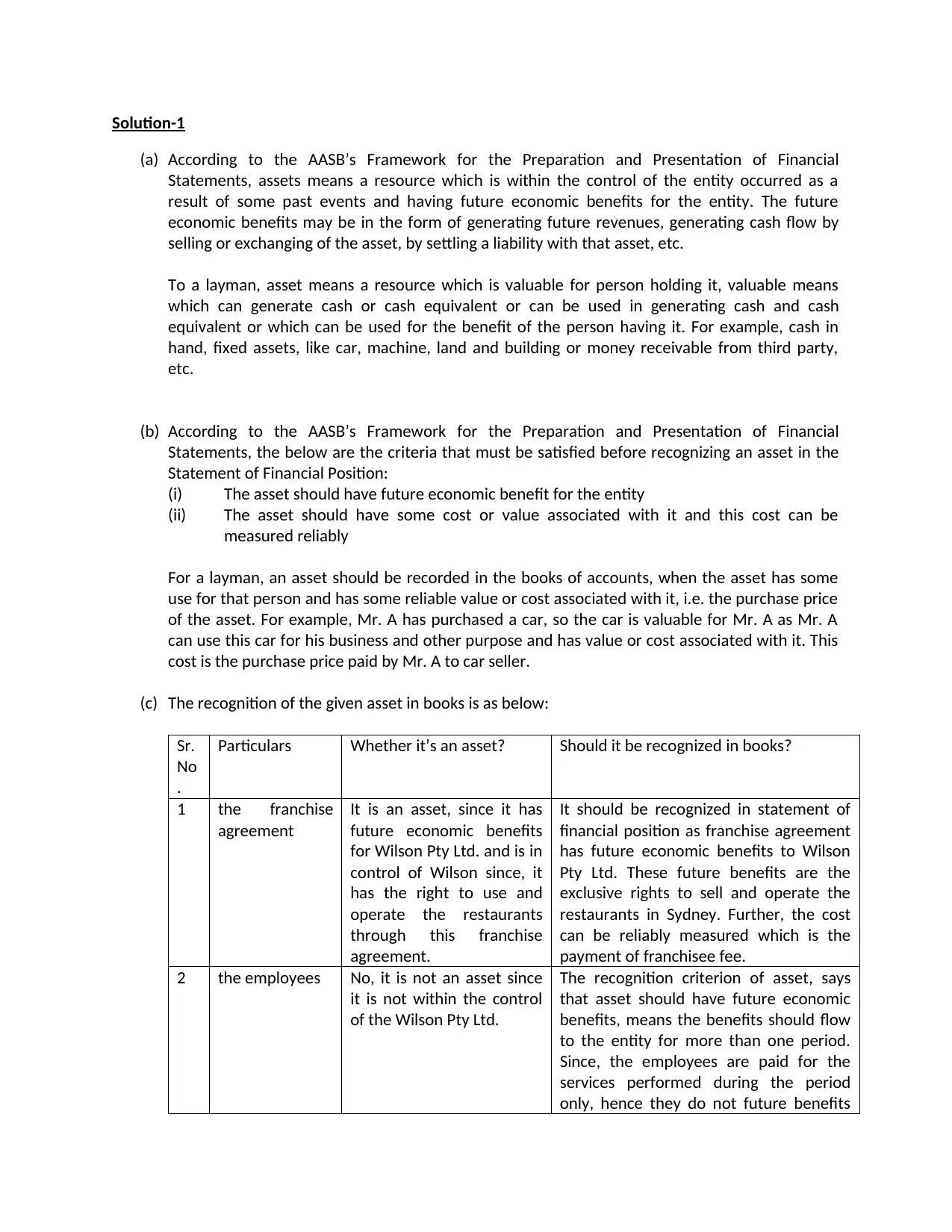
Solution-1
(a) According to the AASB’s Framework for the Preparation and Presentation of Financial
Statements, assets means a resource which is within the control of the entity occurred as a
result of some past events and having future economic benefits for the entity. The future
economic benefits may be in the form of generating future revenues, generating cash flow by
selling or exchanging of the asset, by settling a liability with that asset, etc.
To a layman, asset means a resource which is valuable for person holding it, valuable means
which can generate cash or cash equivalent or can be used in generating cash and cash
equivalent or which can be used for the benefit of the person having it. For example, cash in
hand, fixed assets, like car, machine, land and building or money receivable from third party,
etc.
(b) According to the AASB’s Framework for the Preparation and Presentation of Financial
Statements, the below are the criteria that must be satisfied before recognizing an asset in the
Statement of Financial Position:
(i) The asset should have future economic benefit for the entity
(ii) The asset should have some cost or value associated with it and this cost can be
measured reliably
For a layman, an asset should be recorded in the books of accounts, when the asset has some
use for that person and has some reliable value or cost associated with it, i.e. the purchase price
of the asset. For example, Mr. A has purchased a car, so the car is valuable for Mr. A as Mr. A
can use this car for his business and other purpose and has value or cost associated with it. This
cost is the purchase price paid by Mr. A to car seller.
(c) The recognition of the given asset in books is as below:
Sr.
No
.
Particulars Whether it’s an asset? Should it be recognized in books?
1 the franchise
agreement
It is an asset, since it has
future economic benefits
for Wilson Pty Ltd. and is in
control of Wilson since, it
has the right to use and
operate the restaurants
through this franchise
agreement.
It should be recognized in statement of
financial position as franchise agreement
has future economic benefits to Wilson
Pty Ltd. These future benefits are the
exclusive rights to sell and operate the
restaurants in Sydney. Further, the cost
can be reliably measured which is the
payment of franchisee fee.
2 the employees No, it is not an asset since
it is not within the control
of the Wilson Pty Ltd.
The recognition criterion of asset, says
that asset should have future economic
benefits, means the benefits should flow
to the entity for more than one period.
Since, the employees are paid for the
services performed during the period
only, hence they do not future benefits
(a) According to the AASB’s Framework for the Preparation and Presentation of Financial
Statements, assets means a resource which is within the control of the entity occurred as a
result of some past events and having future economic benefits for the entity. The future
economic benefits may be in the form of generating future revenues, generating cash flow by
selling or exchanging of the asset, by settling a liability with that asset, etc.
To a layman, asset means a resource which is valuable for person holding it, valuable means
which can generate cash or cash equivalent or can be used in generating cash and cash
equivalent or which can be used for the benefit of the person having it. For example, cash in
hand, fixed assets, like car, machine, land and building or money receivable from third party,
etc.
(b) According to the AASB’s Framework for the Preparation and Presentation of Financial
Statements, the below are the criteria that must be satisfied before recognizing an asset in the
Statement of Financial Position:
(i) The asset should have future economic benefit for the entity
(ii) The asset should have some cost or value associated with it and this cost can be
measured reliably
For a layman, an asset should be recorded in the books of accounts, when the asset has some
use for that person and has some reliable value or cost associated with it, i.e. the purchase price
of the asset. For example, Mr. A has purchased a car, so the car is valuable for Mr. A as Mr. A
can use this car for his business and other purpose and has value or cost associated with it. This
cost is the purchase price paid by Mr. A to car seller.
(c) The recognition of the given asset in books is as below:
Sr.
No
.
Particulars Whether it’s an asset? Should it be recognized in books?
1 the franchise
agreement
It is an asset, since it has
future economic benefits
for Wilson Pty Ltd. and is in
control of Wilson since, it
has the right to use and
operate the restaurants
through this franchise
agreement.
It should be recognized in statement of
financial position as franchise agreement
has future economic benefits to Wilson
Pty Ltd. These future benefits are the
exclusive rights to sell and operate the
restaurants in Sydney. Further, the cost
can be reliably measured which is the
payment of franchisee fee.
2 the employees No, it is not an asset since
it is not within the control
of the Wilson Pty Ltd.
The recognition criterion of asset, says
that asset should have future economic
benefits, means the benefits should flow
to the entity for more than one period.
Since, the employees are paid for the
services performed during the period
only, hence they do not future benefits
Paraphrase This Document
Need a fresh take? Get an instant paraphrase of this document with our AI Paraphraser
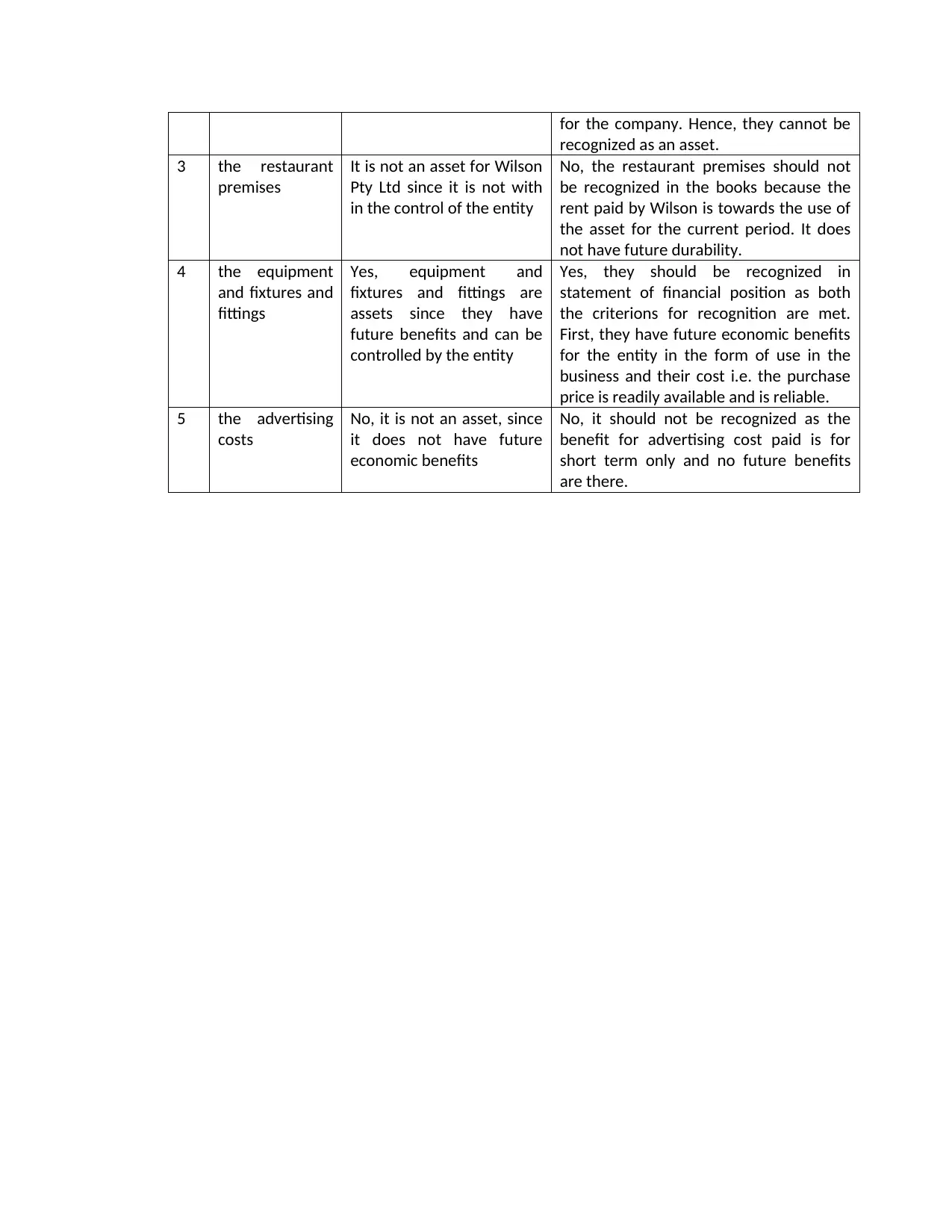
for the company. Hence, they cannot be
recognized as an asset.
3 the restaurant
premises
It is not an asset for Wilson
Pty Ltd since it is not with
in the control of the entity
No, the restaurant premises should not
be recognized in the books because the
rent paid by Wilson is towards the use of
the asset for the current period. It does
not have future durability.
4 the equipment
and fixtures and
fittings
Yes, equipment and
fixtures and fittings are
assets since they have
future benefits and can be
controlled by the entity
Yes, they should be recognized in
statement of financial position as both
the criterions for recognition are met.
First, they have future economic benefits
for the entity in the form of use in the
business and their cost i.e. the purchase
price is readily available and is reliable.
5 the advertising
costs
No, it is not an asset, since
it does not have future
economic benefits
No, it should not be recognized as the
benefit for advertising cost paid is for
short term only and no future benefits
are there.
recognized as an asset.
3 the restaurant
premises
It is not an asset for Wilson
Pty Ltd since it is not with
in the control of the entity
No, the restaurant premises should not
be recognized in the books because the
rent paid by Wilson is towards the use of
the asset for the current period. It does
not have future durability.
4 the equipment
and fixtures and
fittings
Yes, equipment and
fixtures and fittings are
assets since they have
future benefits and can be
controlled by the entity
Yes, they should be recognized in
statement of financial position as both
the criterions for recognition are met.
First, they have future economic benefits
for the entity in the form of use in the
business and their cost i.e. the purchase
price is readily available and is reliable.
5 the advertising
costs
No, it is not an asset, since
it does not have future
economic benefits
No, it should not be recognized as the
benefit for advertising cost paid is for
short term only and no future benefits
are there.
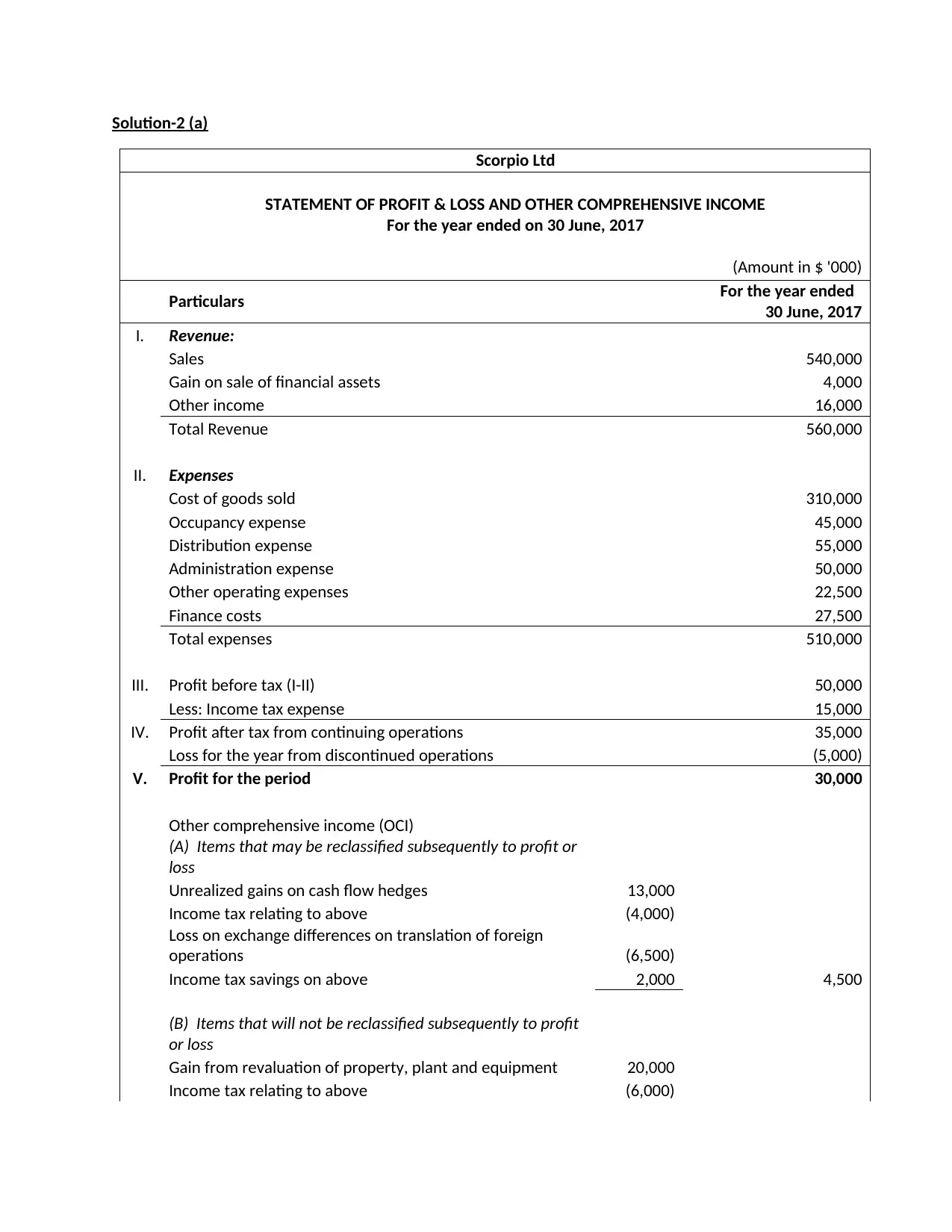
Solution-2 (a)
Scorpio Ltd
STATEMENT OF PROFIT & LOSS AND OTHER COMPREHENSIVE INCOME
For the year ended on 30 June, 2017
(Amount in $ '000)
Particulars For the year ended
30 June, 2017
I. Revenue:
Sales 540,000
Gain on sale of financial assets 4,000
Other income 16,000
Total Revenue 560,000
II. Expenses
Cost of goods sold 310,000
Occupancy expense 45,000
Distribution expense 55,000
Administration expense 50,000
Other operating expenses 22,500
Finance costs 27,500
Total expenses 510,000
III. Profit before tax (I-II) 50,000
Less: Income tax expense 15,000
IV. Profit after tax from continuing operations 35,000
Loss for the year from discontinued operations (5,000)
V. Profit for the period 30,000
Other comprehensive income (OCI)
(A) Items that may be reclassified subsequently to profit or
loss
Unrealized gains on cash flow hedges 13,000
Income tax relating to above (4,000)
Loss on exchange differences on translation of foreign
operations (6,500)
Income tax savings on above 2,000 4,500
(B) Items that will not be reclassified subsequently to profit
or loss
Gain from revaluation of property, plant and equipment 20,000
Income tax relating to above (6,000)
Scorpio Ltd
STATEMENT OF PROFIT & LOSS AND OTHER COMPREHENSIVE INCOME
For the year ended on 30 June, 2017
(Amount in $ '000)
Particulars For the year ended
30 June, 2017
I. Revenue:
Sales 540,000
Gain on sale of financial assets 4,000
Other income 16,000
Total Revenue 560,000
II. Expenses
Cost of goods sold 310,000
Occupancy expense 45,000
Distribution expense 55,000
Administration expense 50,000
Other operating expenses 22,500
Finance costs 27,500
Total expenses 510,000
III. Profit before tax (I-II) 50,000
Less: Income tax expense 15,000
IV. Profit after tax from continuing operations 35,000
Loss for the year from discontinued operations (5,000)
V. Profit for the period 30,000
Other comprehensive income (OCI)
(A) Items that may be reclassified subsequently to profit or
loss
Unrealized gains on cash flow hedges 13,000
Income tax relating to above (4,000)
Loss on exchange differences on translation of foreign
operations (6,500)
Income tax savings on above 2,000 4,500
(B) Items that will not be reclassified subsequently to profit
or loss
Gain from revaluation of property, plant and equipment 20,000
Income tax relating to above (6,000)
⊘ This is a preview!⊘
Do you want full access?
Subscribe today to unlock all pages.

Trusted by 1+ million students worldwide
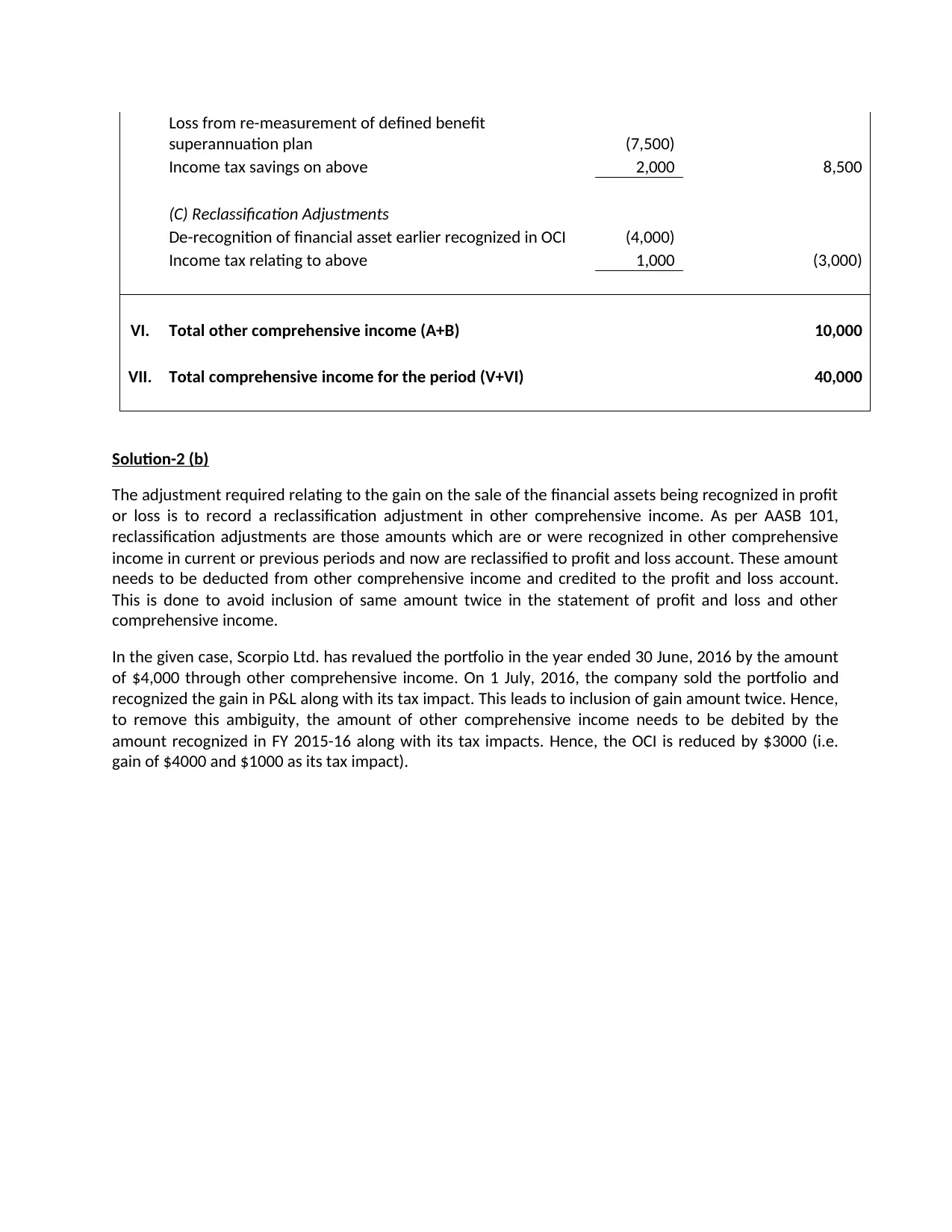
Loss from re-measurement of defined benefit
superannuation plan (7,500)
Income tax savings on above 2,000 8,500
(C) Reclassification Adjustments
De-recognition of financial asset earlier recognized in OCI (4,000)
Income tax relating to above 1,000 (3,000)
VI. Total other comprehensive income (A+B) 10,000
VII. Total comprehensive income for the period (V+VI) 40,000
Solution-2 (b)
The adjustment required relating to the gain on the sale of the financial assets being recognized in profit
or loss is to record a reclassification adjustment in other comprehensive income. As per AASB 101,
reclassification adjustments are those amounts which are or were recognized in other comprehensive
income in current or previous periods and now are reclassified to profit and loss account. These amount
needs to be deducted from other comprehensive income and credited to the profit and loss account.
This is done to avoid inclusion of same amount twice in the statement of profit and loss and other
comprehensive income.
In the given case, Scorpio Ltd. has revalued the portfolio in the year ended 30 June, 2016 by the amount
of $4,000 through other comprehensive income. On 1 July, 2016, the company sold the portfolio and
recognized the gain in P&L along with its tax impact. This leads to inclusion of gain amount twice. Hence,
to remove this ambiguity, the amount of other comprehensive income needs to be debited by the
amount recognized in FY 2015-16 along with its tax impacts. Hence, the OCI is reduced by $3000 (i.e.
gain of $4000 and $1000 as its tax impact).
superannuation plan (7,500)
Income tax savings on above 2,000 8,500
(C) Reclassification Adjustments
De-recognition of financial asset earlier recognized in OCI (4,000)
Income tax relating to above 1,000 (3,000)
VI. Total other comprehensive income (A+B) 10,000
VII. Total comprehensive income for the period (V+VI) 40,000
Solution-2 (b)
The adjustment required relating to the gain on the sale of the financial assets being recognized in profit
or loss is to record a reclassification adjustment in other comprehensive income. As per AASB 101,
reclassification adjustments are those amounts which are or were recognized in other comprehensive
income in current or previous periods and now are reclassified to profit and loss account. These amount
needs to be deducted from other comprehensive income and credited to the profit and loss account.
This is done to avoid inclusion of same amount twice in the statement of profit and loss and other
comprehensive income.
In the given case, Scorpio Ltd. has revalued the portfolio in the year ended 30 June, 2016 by the amount
of $4,000 through other comprehensive income. On 1 July, 2016, the company sold the portfolio and
recognized the gain in P&L along with its tax impact. This leads to inclusion of gain amount twice. Hence,
to remove this ambiguity, the amount of other comprehensive income needs to be debited by the
amount recognized in FY 2015-16 along with its tax impacts. Hence, the OCI is reduced by $3000 (i.e.
gain of $4000 and $1000 as its tax impact).
Paraphrase This Document
Need a fresh take? Get an instant paraphrase of this document with our AI Paraphraser
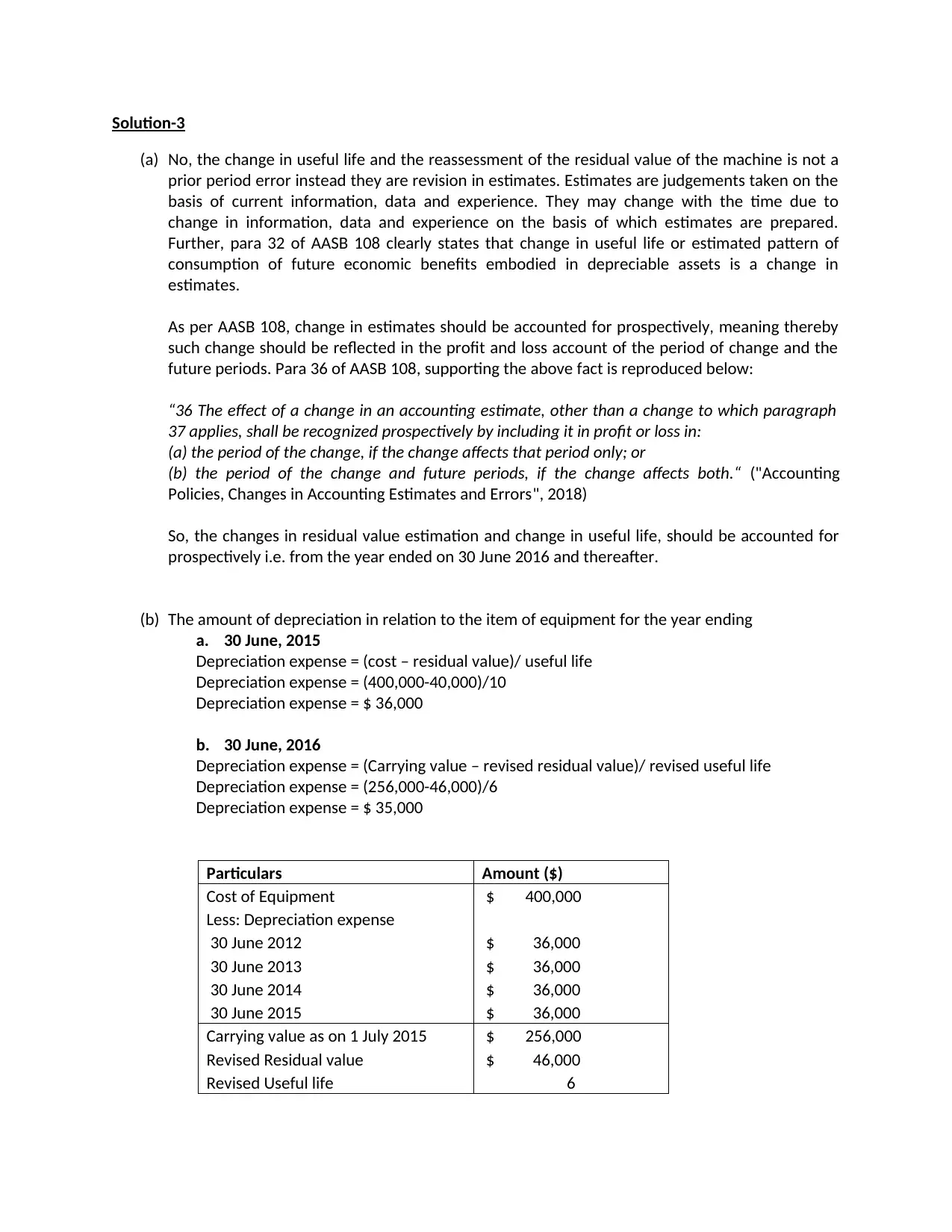
Solution-3
(a) No, the change in useful life and the reassessment of the residual value of the machine is not a
prior period error instead they are revision in estimates. Estimates are judgements taken on the
basis of current information, data and experience. They may change with the time due to
change in information, data and experience on the basis of which estimates are prepared.
Further, para 32 of AASB 108 clearly states that change in useful life or estimated pattern of
consumption of future economic benefits embodied in depreciable assets is a change in
estimates.
As per AASB 108, change in estimates should be accounted for prospectively, meaning thereby
such change should be reflected in the profit and loss account of the period of change and the
future periods. Para 36 of AASB 108, supporting the above fact is reproduced below:
“36 The effect of a change in an accounting estimate, other than a change to which paragraph
37 applies, shall be recognized prospectively by including it in profit or loss in:
(a) the period of the change, if the change affects that period only; or
(b) the period of the change and future periods, if the change affects both.“ ("Accounting
Policies, Changes in Accounting Estimates and Errors", 2018)
So, the changes in residual value estimation and change in useful life, should be accounted for
prospectively i.e. from the year ended on 30 June 2016 and thereafter.
(b) The amount of depreciation in relation to the item of equipment for the year ending
a. 30 June, 2015
Depreciation expense = (cost – residual value)/ useful life
Depreciation expense = (400,000-40,000)/10
Depreciation expense = $ 36,000
b. 30 June, 2016
Depreciation expense = (Carrying value – revised residual value)/ revised useful life
Depreciation expense = (256,000-46,000)/6
Depreciation expense = $ 35,000
Particulars Amount ($)
Cost of Equipment $ 400,000
Less: Depreciation expense
30 June 2012 $ 36,000
30 June 2013 $ 36,000
30 June 2014 $ 36,000
30 June 2015 $ 36,000
Carrying value as on 1 July 2015 $ 256,000
Revised Residual value $ 46,000
Revised Useful life 6
(a) No, the change in useful life and the reassessment of the residual value of the machine is not a
prior period error instead they are revision in estimates. Estimates are judgements taken on the
basis of current information, data and experience. They may change with the time due to
change in information, data and experience on the basis of which estimates are prepared.
Further, para 32 of AASB 108 clearly states that change in useful life or estimated pattern of
consumption of future economic benefits embodied in depreciable assets is a change in
estimates.
As per AASB 108, change in estimates should be accounted for prospectively, meaning thereby
such change should be reflected in the profit and loss account of the period of change and the
future periods. Para 36 of AASB 108, supporting the above fact is reproduced below:
“36 The effect of a change in an accounting estimate, other than a change to which paragraph
37 applies, shall be recognized prospectively by including it in profit or loss in:
(a) the period of the change, if the change affects that period only; or
(b) the period of the change and future periods, if the change affects both.“ ("Accounting
Policies, Changes in Accounting Estimates and Errors", 2018)
So, the changes in residual value estimation and change in useful life, should be accounted for
prospectively i.e. from the year ended on 30 June 2016 and thereafter.
(b) The amount of depreciation in relation to the item of equipment for the year ending
a. 30 June, 2015
Depreciation expense = (cost – residual value)/ useful life
Depreciation expense = (400,000-40,000)/10
Depreciation expense = $ 36,000
b. 30 June, 2016
Depreciation expense = (Carrying value – revised residual value)/ revised useful life
Depreciation expense = (256,000-46,000)/6
Depreciation expense = $ 35,000
Particulars Amount ($)
Cost of Equipment $ 400,000
Less: Depreciation expense
30 June 2012 $ 36,000
30 June 2013 $ 36,000
30 June 2014 $ 36,000
30 June 2015 $ 36,000
Carrying value as on 1 July 2015 $ 256,000
Revised Residual value $ 46,000
Revised Useful life 6

⊘ This is a preview!⊘
Do you want full access?
Subscribe today to unlock all pages.

Trusted by 1+ million students worldwide
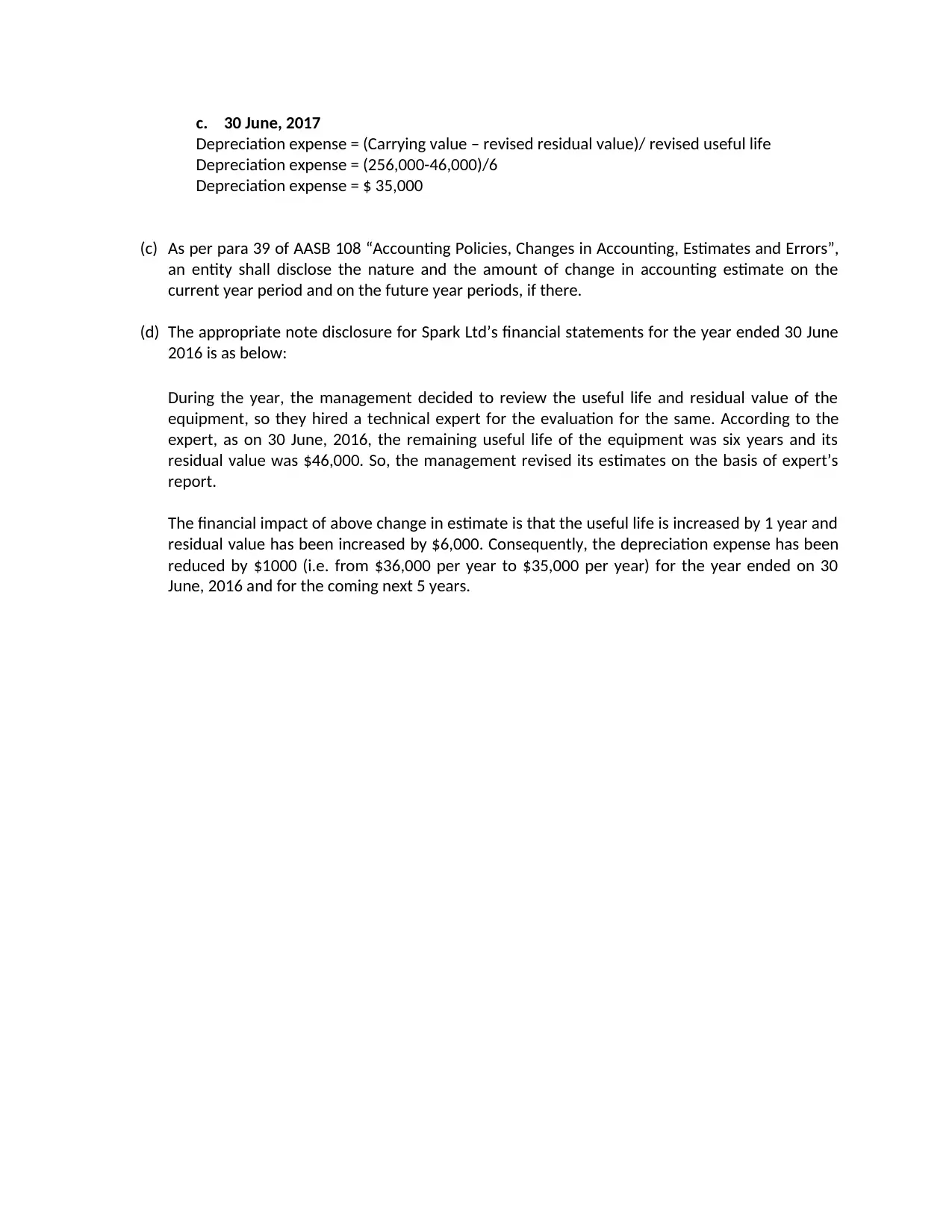
c. 30 June, 2017
Depreciation expense = (Carrying value – revised residual value)/ revised useful life
Depreciation expense = (256,000-46,000)/6
Depreciation expense = $ 35,000
(c) As per para 39 of AASB 108 “Accounting Policies, Changes in Accounting, Estimates and Errors”,
an entity shall disclose the nature and the amount of change in accounting estimate on the
current year period and on the future year periods, if there.
(d) The appropriate note disclosure for Spark Ltd’s financial statements for the year ended 30 June
2016 is as below:
During the year, the management decided to review the useful life and residual value of the
equipment, so they hired a technical expert for the evaluation for the same. According to the
expert, as on 30 June, 2016, the remaining useful life of the equipment was six years and its
residual value was $46,000. So, the management revised its estimates on the basis of expert’s
report.
The financial impact of above change in estimate is that the useful life is increased by 1 year and
residual value has been increased by $6,000. Consequently, the depreciation expense has been
reduced by $1000 (i.e. from $36,000 per year to $35,000 per year) for the year ended on 30
June, 2016 and for the coming next 5 years.
Depreciation expense = (Carrying value – revised residual value)/ revised useful life
Depreciation expense = (256,000-46,000)/6
Depreciation expense = $ 35,000
(c) As per para 39 of AASB 108 “Accounting Policies, Changes in Accounting, Estimates and Errors”,
an entity shall disclose the nature and the amount of change in accounting estimate on the
current year period and on the future year periods, if there.
(d) The appropriate note disclosure for Spark Ltd’s financial statements for the year ended 30 June
2016 is as below:
During the year, the management decided to review the useful life and residual value of the
equipment, so they hired a technical expert for the evaluation for the same. According to the
expert, as on 30 June, 2016, the remaining useful life of the equipment was six years and its
residual value was $46,000. So, the management revised its estimates on the basis of expert’s
report.
The financial impact of above change in estimate is that the useful life is increased by 1 year and
residual value has been increased by $6,000. Consequently, the depreciation expense has been
reduced by $1000 (i.e. from $36,000 per year to $35,000 per year) for the year ended on 30
June, 2016 and for the coming next 5 years.
Paraphrase This Document
Need a fresh take? Get an instant paraphrase of this document with our AI Paraphraser
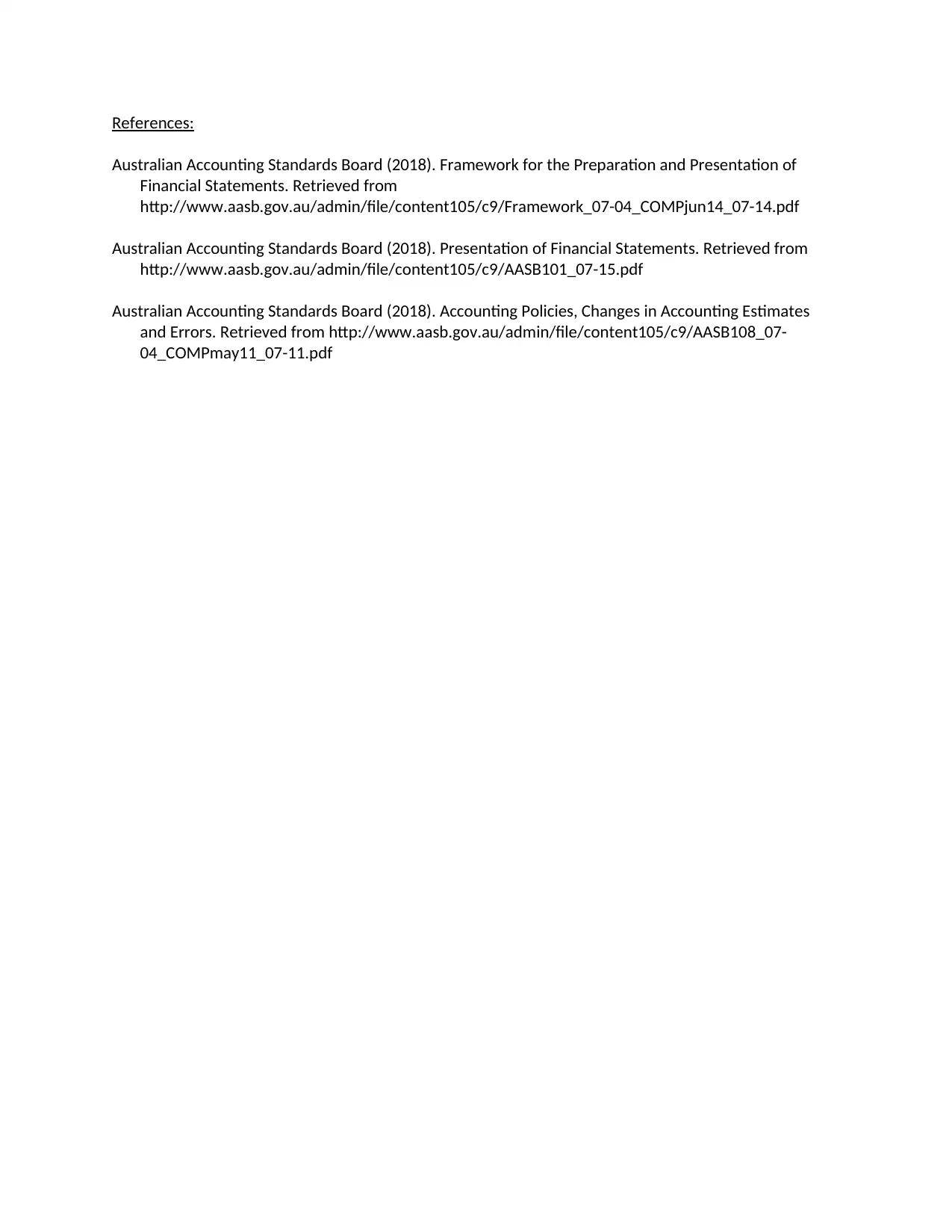
References:
Australian Accounting Standards Board (2018). Framework for the Preparation and Presentation of
Financial Statements. Retrieved from
http://www.aasb.gov.au/admin/file/content105/c9/Framework_07-04_COMPjun14_07-14.pdf
Australian Accounting Standards Board (2018). Presentation of Financial Statements. Retrieved from
http://www.aasb.gov.au/admin/file/content105/c9/AASB101_07-15.pdf
Australian Accounting Standards Board (2018). Accounting Policies, Changes in Accounting Estimates
and Errors. Retrieved from http://www.aasb.gov.au/admin/file/content105/c9/AASB108_07-
04_COMPmay11_07-11.pdf
Australian Accounting Standards Board (2018). Framework for the Preparation and Presentation of
Financial Statements. Retrieved from
http://www.aasb.gov.au/admin/file/content105/c9/Framework_07-04_COMPjun14_07-14.pdf
Australian Accounting Standards Board (2018). Presentation of Financial Statements. Retrieved from
http://www.aasb.gov.au/admin/file/content105/c9/AASB101_07-15.pdf
Australian Accounting Standards Board (2018). Accounting Policies, Changes in Accounting Estimates
and Errors. Retrieved from http://www.aasb.gov.au/admin/file/content105/c9/AASB108_07-
04_COMPmay11_07-11.pdf
1 out of 8
Related Documents
Your All-in-One AI-Powered Toolkit for Academic Success.
+13062052269
info@desklib.com
Available 24*7 on WhatsApp / Email
![[object Object]](/_next/static/media/star-bottom.7253800d.svg)
Unlock your academic potential
Copyright © 2020–2025 A2Z Services. All Rights Reserved. Developed and managed by ZUCOL.





